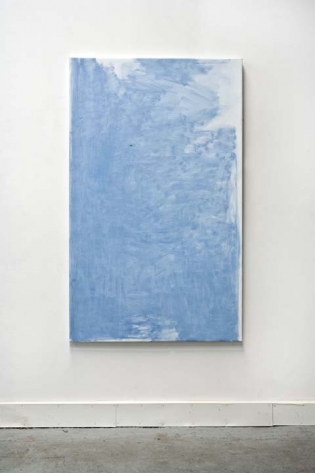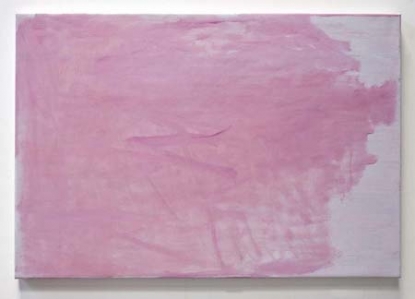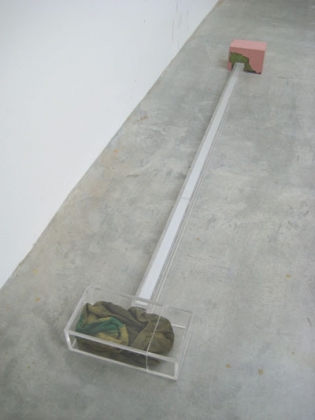Feature: Reviews
John Beech & John Zurier
- Gallery Paule Anglim
- San Francisco
- June 10, 2009 - July 11, 2009
The work of two Johns, Beech and Zurier, commingle throughout Gallery Paule Anglim in an engaging pas de deux. There are seven pale-blue Zurier paintings and two lanky Beech sculptures in the main gallery. The overall effect of this room is sensible and straightforward, the strong and silent type of masculine: reductive works, buttoned-down gray-blues, vertical formats, I-Beam structures. The smaller room offers a florid contrast of rococo effulgence: decorative horizontal stripes, vibrant pinks and a tangy yellow ochre.
A rare sight in painting these days, Zurier’s work is all about kinetics: movement, inflection, speed (...the slow speed of watching clouds accrue.) In Akeshov, 2009, a soft veil of subdued gestures which barely show the bristles of the brush is offset by a single, small, aberrant, and wholly compelling comma of viridian. These paintings have a very specific surface whose lack of impasto contrasts with their gestural vocabulary. “Like breath on the surface of a pane of glass,” they sometimes have a photographic quality: the paint film falls like a shadow on the support, stopping just short of the edge, or pushing out past it, leaving behind a shape which implies a silhouette of…something. If this is landscape, it’s a building or a mesa, not a field. The grayed-out, pastel blue and the vertical formats recall the looming cerulean silhouettes of Monet’s foggy-day cathedrals. Looming, in a low-key way, is the trope for these paintings. Like spirit photography, there is a not quite figurative “presence” in the fog—or the fog of paint-film itself is that presence.
Zurier likes his painting at the limit: paint testing the edge of the support; abstraction testing the limit of imagistic painting; painting at the limit of becoming something else (sculpture, stain, mess). The simplicity of these paintings would verge on laziness if it weren’t for the bare attention Zurier brings to all the decisions involved. The result avoids an uptight vibe; Zurier deals in recognition not restraint. The transition to a louder color key in the smaller room is a welcome counterpoint for this show which might otherwise suffer from an overabundance of elegance.
Most of Beech’s works here are constructions of plexiglass boxes, their surfaces sometimes clear, sometimes frosted messily with paint—the paint sometimes scraped off again. Their interiors contain metal “armatures” and in one case, rumpled, dirty sweatpants. They hang around Zurier’s refined paintings like witty and handsome car mechanics with grease stains on their clothes. With their brutish surfaces and humor, these are formally precise, quirky and complex sculptures. These objects toy with the notion of usefulness, hovering somewhere between noun and verb.
What is actually going on in Pink Follower differs from its initial read: a stack of plexi boxes glowing with scraped pink paint and “decorative” horizontal stripes. A closer look and the stripes are an effect of the “necessary” metal armature visible inside the strange glowing carapace. But then the “armature” is seen to serve no structural purpose. It consists of found objects (a rack for stacking cafeteria trays, a hanging-file holder) all now removed from their “use.” They become objects in a crazed vitrine, “uselessly” decorative, but useful once-upon-a-time. They remain strong, precise, and still; enclosed in a gorgeous pink skin. Beech’s work is like Gene Kelly’s dancing, all masculine grace and assurance, not a parody but the real deal: brute strength and vulnerability, delicate and bold, funny, athletic, charming.



